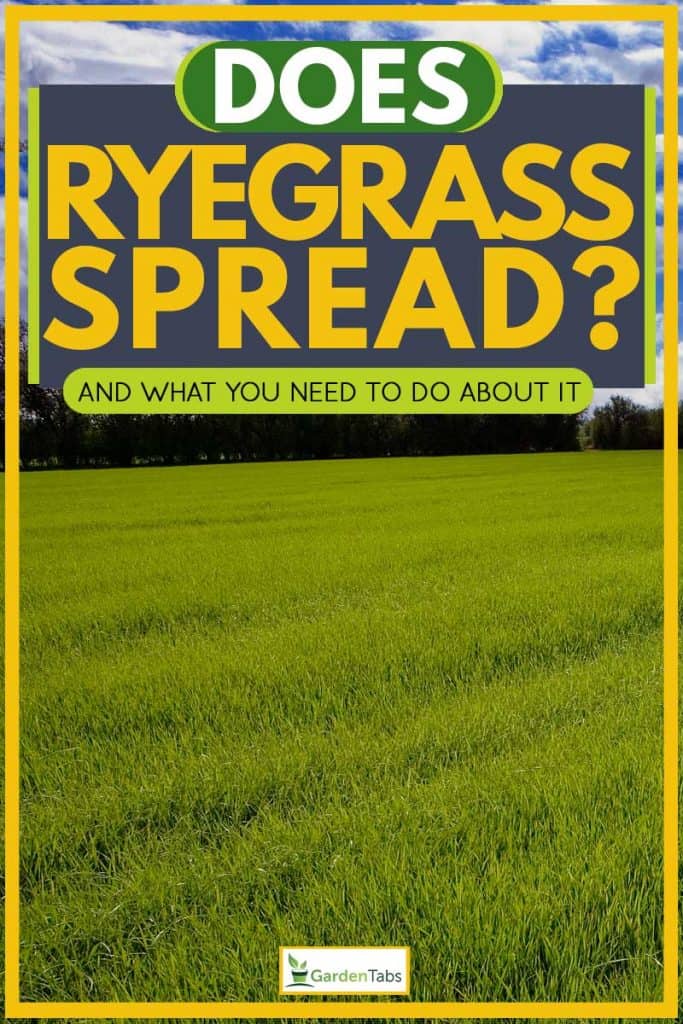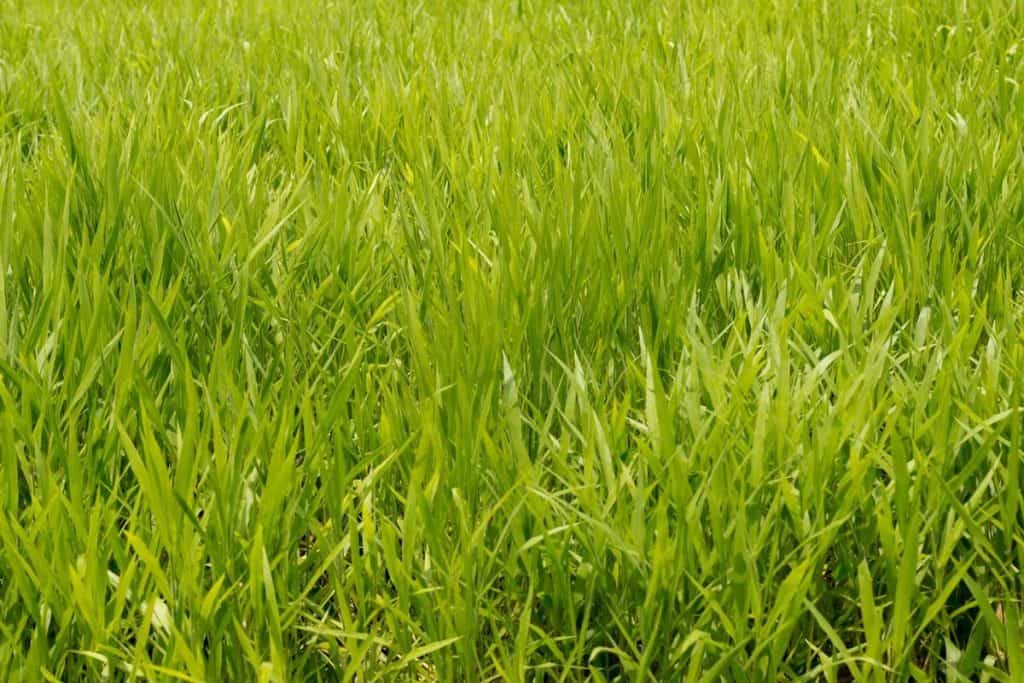This article was reviewed by Steve Snedeker, professional landscaper.
 Perennial ryegrass is a hardy, cool-climate grass that germinates quickly and adds vibrant green color to your lawn. If you plan to use perennial ryegrass for your yard, you might be wondering does ryegrass spread? We’ve done the research to provide you with the answer.
Perennial ryegrass is a hardy, cool-climate grass that germinates quickly and adds vibrant green color to your lawn. If you plan to use perennial ryegrass for your yard, you might be wondering does ryegrass spread? We’ve done the research to provide you with the answer.
Perennial ryegrass does not spread naturally because it does not produce rhizomes or stolons. To plant an area of your lawn with perennial ryegrass, you’ll have to seed or lay sod on the entire area.
There are different types of ryegrass, including annual and biennial varieties. Ryegrass has a variety of applications as a sturdy grass used for lawns, turf, and erosion protection. It is also a nutrient-rich grass planted as forage and planted during crop rotation to aid soil rehabilitation.
We’ve focused on perennial ryegrass because this variety is most commonly included in grass seed blends when planted as lawns and turf. Keep reading, and we’ll discuss the benefits of sowing your lawn with perennial ryegrass.
Does Ryegrass Spread Yearly?
Because perennial ryegrass does not produce rhizomes or stolons, it does not spread. Other, more aggressive grass species can spread rapidly by producing below ground stems called rhizomes, or above-ground stems called stolons. Perennial ryegrass will return each year in the area where it was planted but, it will not spread naturally throughout the lawn.
Growing as a bunchgrass with a shallow root system, perennial ryegrass has a tendency of being patchy. So, it is often paired with aggressive grasses, like Kentucky bluegrass and bermudagrass, when combined in grass seed blends. Perennial ryegrass acts as a nurse grass, providing shade and soil protection as the other grasses grow and spread throughout the lawn.
Does Ryegrass Reseed Itself?
Mowing your lawn regularly will prevent perennial ryegrass from reseeding itself. Mowing also helps to keep your grass healthy because the plant expends energy on growth rather than reproduction. Growing plants retain nutrients within their roots, stems, and leaves. Plants that are reproducing, or going to seed, redistribute these nutrients into flower and seed production. So, a mowed lawn will continue to grow and retain its green color and robust blades.
Perennial ryegrass will return year after year, by going dormant to protect itself during extreme temperatures and drought. When environmental conditions improve the ryegrass revives and continues to grow for up to 5-years before needing to be replaced by planting new seeds.
How Long Does it Take for Ryegrass to Grow?
Ryegrass germinates quickly, so you’ll observe sprouting from the seeds within three days of planting, and your lawn will grow into mow-able grass within 21 days. Perennial ryegrass thrives in cooler climates with its peak growth period occurring from late spring into early summer months.
Planting
During the fall or spring is the best time to seed or sod your lawn with perennial ryegrass, ideally when outdoor air temperatures range between 60 to 75 degrees Fahrenheit. Perennial ryegrass can become dormant during extreme temperatures. During dormancy, typically summer or winter months, you might notice yellowed blades of grass in your lawn and less growth.
Watering
Perennial ryegrass does prefer to be well irrigated, so, especially during periods of hot temperatures or low rainfall, make sure to water your lawn. Sufficient water will help perennial ryegrass to maintain its brilliant green and to avoid dormancy during periods of drought.
Soil Conditions
Adaptable to a variety of nutrient-rich, well-drained soil types, perennial ryegrass prefers a pH balance between 5.5 and 7.5 for optimal growth. Fertilizing your lawn can accelerate growth and maintain healthy grass. Follow the manufacturer’s instructions and keep an eye on your lawn’s condition to avoid over-fertilizing.
If you are curious about the nutrient levels in your soil, contact the local county extension agent or regional agronomist for a soil sample kit and instructions on how to provide a soil sample.
Mowing
Generally, mowing your lawn at higher heights promotes healthy root systems. It is recommended for perennial ryegrass that you mow at a height between 1-1/2 to 3 inches. Particularly during hot months, keeping perennial ryegrass taller will make it less susceptible to heat or drought.
Will Ryegrass Choke Out Weeds?

Perennial ryegrass’ shallow, dense root system prohibits weeds from growing in the same vicinity. Additionally, it is an allelopathic plant meaning that it can release chemicals into the soil as a defense mechanism to prohibit neighboring plants from infringing on the same soil.
Perennial ryegrass’ allelopathic capability is helpful to defend against weeds but, if overseeded with bermudagrass, the ryegrass can be detrimental to the bermudagrass.
Since perennial ryegrass does not spread naturally, weeds can infiltrate any thinned or bare areas of your lawn. To prevent weeds and to maintain a lush lawn, you can reseed any thinned or exposed areas. You might also consider seeding your lawn with a grass seed blend so that other grasses can spread among the perennial ryegrass bunches.
Is Ryegrass Good for a Lawn?
Perennial ryegrass as a stand-alone plant has pros and cons when used for your entire lawn.
Pros
- Fast germination and ongoing growth.
- Prefers ample sunlight but, tolerates shade.
- High wear tolerance, ideal for high-traffic lawn areas or turf.
- Sturdy root system protects soil from erosion.
- The dense root system and allopathic characteristics deter weed invasion.
Cons
- It does not tolerate heat.
- It does not tolerate drought.
- Coarse texture.
- Bunchgrass growth can appear patchy.
Mixed with other grasses, perennial ryegrass protects neighboring grasses, strengthens the soil, and adds color to your lawn year after year.
Where to Buy Ryegrass Seed?
If you have questions about your lawn, consider buying your seeds from a local garden supply or seed provider who can provide you recommendations.
If you have a green thumb and are ready to buy seeds without any additional questions, find perennial ryegrass seeds at:
- Local Garden Supply
- Seed Wholesaler
- Walmart
- Agway
- Amazon
Some stores might not stock stand-alone perennial ryegrass seeds because it is more commonly used in grass seed mixes. So, don’t hesitate to ask a store attendant for assistance. In many cases, you’ll be able to pre-order your seeds.
Click here to find this on Amazon.
Perennial ryegrass adds several positive properties to your lawn and is relatively easy to maintain, given the right climate. Now that you know how perennial ryegrass can be used as a stand-alone plant or mixed with other species of grass, you’ll be ready to seed your lawn for a healthy, beautiful space.

